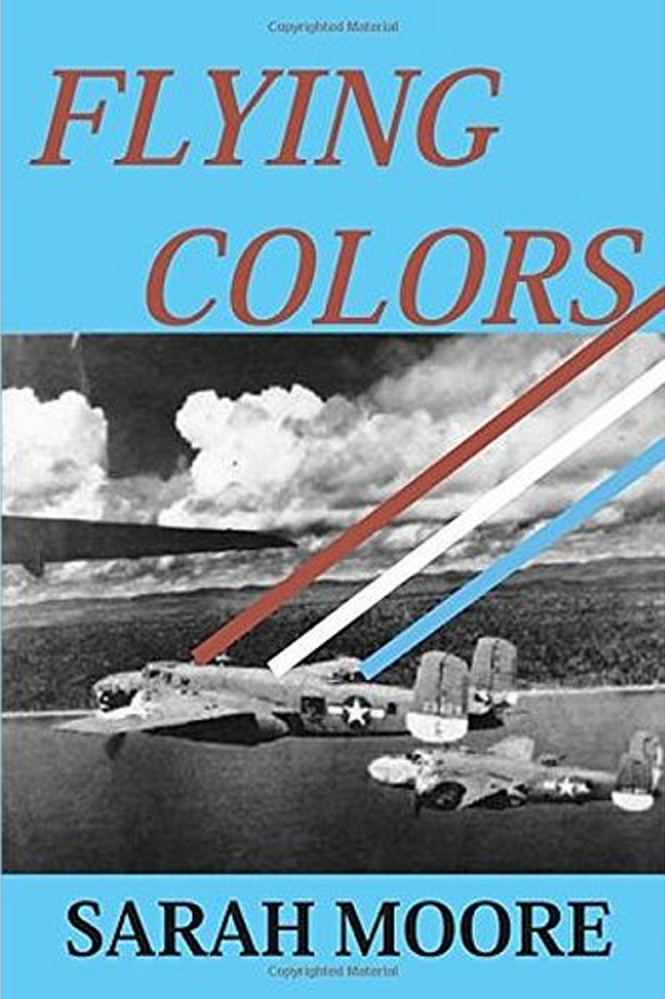Augusta writer Sarah Moore offers an effective, telling account of an airman’s experience during World War II in her third book, “Flying Colors.”
As the introductory material states, “Though not a memoir, it is nostalgic in the same sort of way and reveals more adventure than peril, plus a lot of humor, love and camaraderie, as seen through the personal narrative of Victor ‘Vic’ Tatelman, now 94 years old, who was a cadet in Visalia, California, when Japan attacked Pearl Harbor.”
In short, Moore has given form and readability to Tatelman’s words and recollections in a clear, concise format. The words ring particularly true for this reviewer, whose father was a B-24 navigator in the European Theater during the same conflict. Though Tatelman flew in Asia, the attitudes and occurrences are similar.
Through 30-odd chapters we follow the trajectory of the flyer from flight school to word of the attack on Pearl Harbor to advanced training to the war. Tatelman and his B-25 crew then made the remarkable flight from California to Hawaii to Australia. In the Atlantic, bombers made flights from Newfoundland to the Azores to North Africa, before landing in Italy. I have always been awestruck by such flights, which a decade or two earlier would have been impossible. Suddenly, in the press of a war that had to be won, these crossings became the norm.
When my dad spoke of his experience, it was this plunge into the darkness of the unknown that gripped my attention as much as stories of actual combat. Lindberg and Earhart were still heroic figures, the latter’s fatal flight having happened just four years previously.
Flying in the Pacific required more flights than in Europe, and Tatelman ended up doing two tours of duty and flying 120 missions. The much-decorated officer lost many friends. His early attitude was blunt: “He sought to exact revenge for each and every loss,” Moore writes. “For every American plane that fell from the skies, Vic wanted to see six of the enemy gunned down. Vic and those he flew with saw this as their duty and right. As yet another U.S. plane fell they felt the cold anger of vengeance rise up in them.”
Tatelman’s war took him and his B-25C “Dirty Dora” from bombing in New Guinea to various outposts and island targets. Eventually, it was on to the Philippines and ultimately Japan, where he saw the horrific aftermath of the atomic bombings of Hiroshima and Nagasaki. Tatelman saw the surrender of Japan and occupied Korea close up: “Disembarking from the plane, Gen. Hodge assembled his staff in the parking area and walked smartly to just in front of the enemy troops. He exchanged salutes with the Japanese commander, who presented his sword to the general. As a sign of mutual respect and compassion, Gen. Hodge refused the sword, saying he hoped it would never be drawn in anger again. The meeting ceremony thus concluded, the troops were marched off and the residents of the two governments went into the building.”
Thus the greatest war in history came to one of its conclusions. Tatelman, then a captain and later a lieutenant general, would go on to serve in the Korean War, but that is another story.
“Flying Colors” delivers on its promises, showing the air war in the Pacific through the experience of one observant individual. The story is reality and not about political correctness or second guesses. Tatelman’s persistence, drive and attitude, like those of my late father, kept him alive and sane. There was indeed something special about their generation.
William David Barry is a local historian who has authored/co-authored seven books, including “Maine: The Wilder Side of New England” and “Deering: A Social and Architectural History.” He lives in Portland with his wife, Debra, and their cat, Nadine.
Copy the Story LinkSend questions/comments to the editors.



Success. Please wait for the page to reload. If the page does not reload within 5 seconds, please refresh the page.
Enter your email and password to access comments.
Hi, to comment on stories you must . This profile is in addition to your subscription and website login.
Already have a commenting profile? .
Invalid username/password.
Please check your email to confirm and complete your registration.
Only subscribers are eligible to post comments. Please subscribe or login first for digital access. Here’s why.
Use the form below to reset your password. When you've submitted your account email, we will send an email with a reset code.